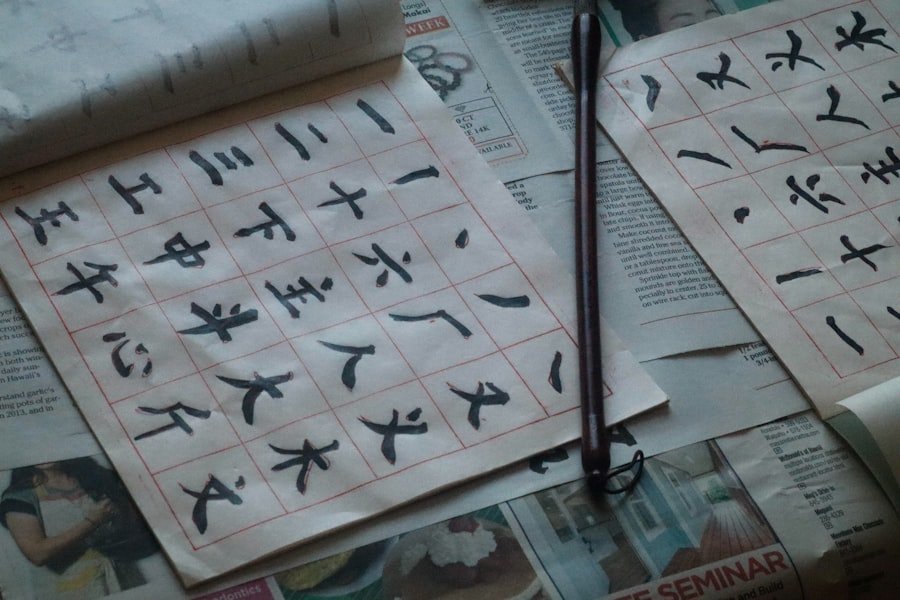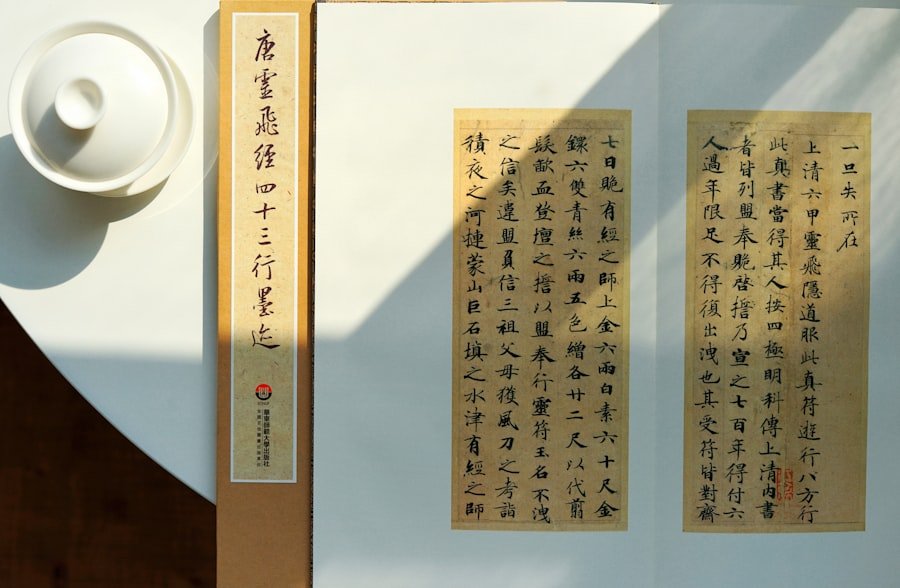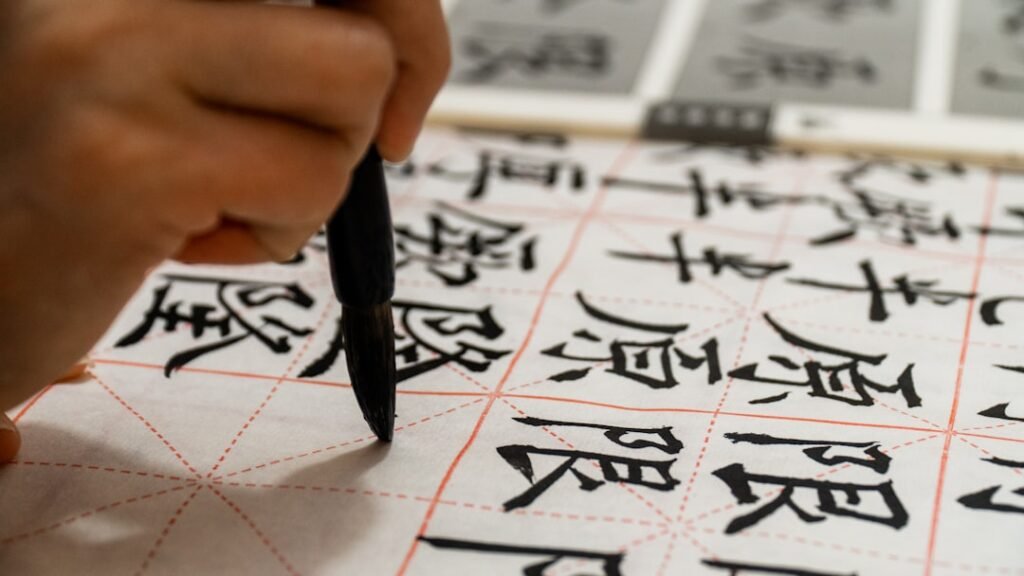Chinese calligraphy is not merely a form of writing; it is an intricate art that embodies the essence of Chinese culture and philosophy. This ancient practice, which dates back thousands of years, is revered for its aesthetic beauty and the deep emotional resonance it can evoke. Each stroke of the brush is a reflection of the artist’s inner state, making calligraphy a unique blend of visual art and personal expression.
The characters themselves are imbued with meaning, and the way they are rendered can convey a multitude of emotions and ideas. At its core, Chinese calligraphy is about balance, rhythm, and flow. The brushwork requires a delicate touch, where each stroke must be executed with precision and intention.
The choice of ink, the quality of the paper, and the type of brush all play significant roles in the final outcome. As practitioners delve deeper into this art form, they discover that it is not just about replicating characters but about expressing one’s individuality through the medium. This understanding lays the foundation for a fulfilling journey into the world of calligraphy. Master the art of Chinese calligraphy. Enroll now at the LC Chinese School in Oslo.
Table of Contents
ToggleSummary
- Chinese calligraphy is a traditional art form that requires an understanding of the cultural and historical significance behind each stroke and character.
- Mental preparation is crucial in calligraphy as it helps to calm the mind, focus attention, and enhance creativity.
- Cultivating a focused mindset is essential for achieving precision and fluidity in calligraphy strokes.
- Breathing techniques can aid in maintaining a steady hand and a relaxed body while practising calligraphy.
- Visualisation and imagery play a key role in creating harmonious and balanced calligraphy compositions.
The Importance of Mental Preparation
Mental preparation is a crucial aspect of mastering Chinese calligraphy. Before even picking up a brush, artists must cultivate a mindset that is conducive to creativity and focus. This preparation involves clearing the mind of distractions and setting intentions for the practice session.
By doing so, calligraphers can create a mental space that allows for deeper engagement with their art. It is in this state of readiness that one can truly appreciate the nuances of each stroke and the beauty of the characters being formed. Moreover, mental preparation helps to establish a connection between the artist and their work.
When one approaches calligraphy with a calm and focused mind, it becomes easier to channel emotions and thoughts into the strokes. This connection not only enhances the quality of the work but also enriches the overall experience of creating art. As practitioners learn to prepare mentally, they often find that their calligraphy becomes more expressive and authentic, reflecting their true selves on paper.
Cultivating a Focused Mindset

Cultivating a focused mindset is essential for anyone looking to excel in Chinese calligraphy. In our fast-paced world, distractions abound, making it challenging to maintain concentration during practice. However, developing focus is not merely about eliminating external distractions; it also involves training the mind to remain present and engaged with the task at hand.
This can be achieved through various techniques, such as setting specific goals for each practice session or creating a dedicated space for calligraphy. A focused mindset allows artists to immerse themselves fully in their work, leading to greater satisfaction and improved results. When practitioners are able to concentrate on each stroke without being sidetracked by thoughts or worries, they can tap into a deeper level of creativity.
This immersion fosters a sense of flow, where time seems to stand still, and the act of writing becomes a meditative experience. As artists continue to cultivate this focused mindset, they often find that their skills develop more rapidly and their enjoyment of the art form deepens.
Breathing Techniques for Calligraphy
Breathing techniques play a vital role in enhancing one’s calligraphy practice. The act of breathing deeply and mindfully can help to calm the mind and centre the body, creating an optimal state for artistic expression. By focusing on breath control, calligraphers can reduce tension and anxiety, allowing for smoother and more fluid brush strokes.
This connection between breath and movement is fundamental in achieving the desired aesthetic in calligraphy. Incorporating breathing exercises into a calligraphy routine can also serve as a form of meditation. Before beginning a session, practitioners might take a few moments to engage in deep breathing, inhaling slowly through the nose and exhaling gently through the mouth.
This practice not only helps to clear the mind but also establishes a rhythm that can be carried into the brushwork itself. As artists learn to synchronise their breathing with their movements, they often find that their calligraphy becomes more expressive and dynamic.
Visualisation and Imagery in Calligraphy
Visualisation is another powerful tool that can enhance one’s calligraphy practice. By mentally picturing the characters before putting brush to paper, artists can create a clearer vision of what they wish to achieve. This technique allows for greater precision in execution, as practitioners can anticipate each stroke and its placement within the overall composition.
Visualisation also encourages creativity, enabling artists to explore different styles and interpretations of characters. Imagery plays an equally important role in this process. Calligraphers often draw inspiration from nature, philosophy, or personal experiences when creating their work.
By visualising these elements, they can infuse their calligraphy with deeper meaning and emotion. For instance, an artist might envision a serene landscape while writing a character that represents peace or harmony. This connection between imagery and calligraphy not only enriches the artistic process but also allows for a more profound expression of one’s thoughts and feelings.
Finding Inspiration and Creativity

Finding inspiration is an essential part of any artistic endeavour, including Chinese calligraphy. Inspiration can come from various sources—nature, literature, history, or even personal experiences. For many calligraphers, immersing themselves in different environments or engaging with diverse cultures can spark new ideas and perspectives.
Visiting galleries or exhibitions showcasing traditional or contemporary calligraphy can also provide fresh insights into techniques and styles. Creativity often flourishes when artists allow themselves to experiment without fear of judgement or failure. Embracing spontaneity in practice sessions can lead to unexpected discoveries and unique expressions.
Whether it involves trying out new brushes or experimenting with different inks and papers, these explorations can open up new avenues for artistic growth. Ultimately, finding inspiration is about remaining open to possibilities and allowing one’s creativity to flow freely.
Overcoming Mental Blocks and Distractions
Mental blocks are common challenges faced by artists at all levels, including those practising Chinese calligraphy. These blocks can manifest as self-doubt, frustration, or a lack of motivation, hindering progress and enjoyment in the art form. Recognising these obstacles is the first step towards overcoming them.
Practitioners may find it helpful to take breaks when feeling stuck or to engage in other creative activities that reignite their passion for calligraphy. Distractions can also impede focus during practice sessions. To combat this, creating a conducive environment is essential—one that minimises interruptions and fosters concentration.
This might involve setting aside specific times for practice when one is least likely to be disturbed or establishing a dedicated workspace that inspires creativity. By addressing both mental blocks and distractions proactively, artists can cultivate a more productive and fulfilling calligraphy practice.
The Role of Emotions in Calligraphy
Emotions play a significant role in Chinese calligraphy, influencing both the process of creation and the final outcome. Each stroke can convey feelings ranging from joy to sorrow, reflecting the artist’s inner state at the moment of writing. This emotional connection adds depth to the artwork, allowing viewers to resonate with the piece on a personal level.
As such, understanding one’s emotions becomes crucial for artists seeking to express themselves authentically through their work. Moreover, engaging with emotions during practice can lead to cathartic experiences for many calligraphers. The act of writing can serve as an outlet for feelings that may be difficult to articulate otherwise.
By allowing emotions to flow through their brushwork, artists often find that their calligraphy becomes more powerful and evocative. This interplay between emotion and artistry not only enhances individual expression but also fosters a deeper appreciation for the art form itself.
Developing Patience and Perseverance
Patience and perseverance are essential qualities for anyone embarking on the journey of mastering Chinese calligraphy. The learning process can be slow and requires consistent practice over time. It is important for artists to recognise that mastery does not come overnight; rather, it is built through dedication and resilience in the face of challenges.
Embracing this journey with patience allows practitioners to appreciate their progress while remaining motivated to improve. Perseverance is equally vital when faced with setbacks or frustrations during practice sessions. Rather than viewing mistakes as failures, artists can learn from them and use them as stepping stones towards growth.
Each stroke offers an opportunity for reflection and improvement; thus, maintaining a positive attitude towards challenges can significantly enhance one’s skills over time. By cultivating patience and perseverance, calligraphers not only develop their technical abilities but also foster a deeper connection with their art.
Mindfulness and Presence in Calligraphy
Mindfulness is an integral aspect of Chinese calligraphy that enhances both the practice itself and the overall experience of creating art. Being present in each moment allows artists to fully engage with their brushwork, leading to greater satisfaction and improved results. Mindfulness encourages practitioners to focus on the sensations of holding the brush, the texture of the paper, and the flow of ink as it glides across the surface—transforming each session into a meditative experience.
Incorporating mindfulness into calligraphy practice can also help alleviate stress and anxiety. As artists immerse themselves in their work, they often find that worries about daily life fade away, replaced by a sense of calm and clarity. This presence not only enriches the artistic process but also contributes to overall well-being.
By embracing mindfulness in their practice, calligraphers can cultivate a deeper appreciation for both their art form and themselves.
Applying Mental Preparation to Improve Calligraphy Skills
The culmination of mental preparation techniques ultimately leads to significant improvements in calligraphy skills. By integrating practices such as focused mindset cultivation, breathing techniques, visualisation exercises, and mindfulness into their routines, artists can enhance their overall performance dramatically. These strategies create an environment where creativity flourishes while allowing for greater emotional expression through brushwork.
At LC Chinese School in Oslo, students have access to specialised courses that emphasise these mental preparation techniques alongside traditional skills training in Chinese calligraphy. The school’s experienced instructors guide learners through various exercises designed to foster focus, creativity, patience, and emotional connection with their art form. By participating in these courses, students not only develop technical proficiency but also cultivate a holistic approach to their practice—one that nurtures both skill development and personal growth.
In conclusion, mastering Chinese calligraphy is an enriching journey that encompasses much more than mere technical skill; it involves mental preparation, emotional engagement, mindfulness practices, and creative exploration. Through courses at LC Chinese School in Oslo, aspiring calligraphers have an opportunity to delve deeply into this beautiful art form while honing their skills in an encouraging environment that values both tradition and personal expression.
Master the art of Chinese calligraphy. Enroll now at the LC Chinese School in Oslo.







